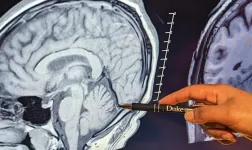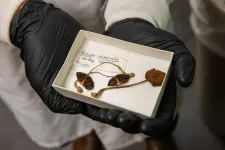(Press-News.org) With tens of thousands of synthetic chemicals on the market, and new ones in development all the time, knowing which ones might be harmful is a challenge both for the federal agencies that regulate them and the companies that use them in products. Now scientists have found a quick way to predict if a chemical is likely to cause breast cancer based on whether the chemical harbors specific traits.
“This new study provides a roadmap for regulators and manufacturers to quickly flag chemicals that could contribute to breast cancer in order to prevent their use in consumer products and find safer alternatives,” says lead author Dr. Jennifer Kay, a research scientist at Silent Spring Institute.
Breast cancer remains the most commonly diagnosed cancer in the United States. Recent data show rates increasing in young women, a trend that can’t be explained by genetics. “We need new tools to identify environmental exposures that could be contributing to this trend so we can develop prevention strategies and reduce the burden of the disease,” says Kay.
Hormone signals
Kay and her colleagues searched through multiple international and U.S. government databases to identify chemicals that have been found to cause mammary tumors in animals. The databases were from the International Agency for Cancer Research (IARC), the National Toxicology Program, the U.S. Environmental Protection Agency (EPA), and the National Cancer Institute, among others.
The researchers also looked at data from EPA’s ToxCast program to identify chemicals that alter the body’s hormones, or endocrine disruptors, in ways that could promote breast cancer. The team looked specifically for chemicals that activate the estrogen receptor—a receptor present in breast cells—as well as chemicals that cause cells to make more estrogen or progesterone, an established risk factor for breast cancer.
Reporting in Environmental Health Perspectives, the researchers identified a total of 921 chemicals that could promote the development of breast cancer. Ninety percent of the chemicals are ones that people are commonly exposed to in consumer products, food and drink, pesticides, medications, and workplaces.
A breakdown of the list revealed 278 chemicals that cause mammary tumors in animals. More than half of the chemicals cause cells to make more estrogen or progesterone, and about a third activate the estrogen receptor. “Breast cancer is a hormonal disease, so the fact that so many chemicals can alter estrogen and progesterone is concerning,” says Kay.
Since damage to DNA can also trigger cancer, the researchers searched additional databases and found 420 of the chemicals on their list both damage DNA and alter hormones, which could make them riskier. What’s more, the team’s analysis found that chemicals that cause mammary tumors in animals are more likely to have these DNA damaging and hormone-disrupting characteristics than ones that don’t.
“Historically, chemicals that cause mammary tumors in animals were seen as the best predictor of whether they might cause breast cancer in humans,” says co-author Ruthann Rudel, director of research at Silent Spring. “But animal studies are expensive and time consuming, which is why so many chemicals have not been tested. Our findings show that screening chemicals for these hormonal traits could be an effective strategy for flagging potential breast carcinogens.”
A roadmap for safety
Over the past decade, there has been growing evidence that environmental chemicals are important contributing factors in the development of cancer. A number of studies in people have found links between breast cancer and pesticides, hair dyes, and air pollution. Other studies suggest exposure to hormone-disrupting chemicals early in life, in the womb or during puberty, can alter breast development in ways that could increase the risk of cancer later on.
To observe those associations, however, scientists have to wait until hundreds or thousands of children and women have been exposed to a chemical and check, often many years later, to see who develops breast cancer. “It’s not feasible, nor is it ethical, to wait that long,” says Rudel. “And it’s another reason why we need better tools for predicting which chemicals are likely to lead to breast cancer so we can avoid those exposures.”
The Silent Spring study could have implications for how EPA assesses chemicals for safety. For instance, the chemicals identified in the study include more than 30 pesticides that EPA previously approved for use despite evidence linking the chemicals with mammary tumors.
This fall, EPA proposed a new strategic plan to ensure that pesticides are evaluated for their effects on hormones. The study authors hope their new comprehensive list of breast cancer-relevant chemicals, which includes hundreds of endocrine disruptors, will inform EPA’s plan and better protect the public from harmful exposures.
Additional co-authors of the new study include Megan Schwarzman at UC Berkeley and Julia Brody at Silent Spring Institute.
Funding for this project was provided by the California Breast Cancer Research Program (Grant #23QB-1881) and charitable donations to the Safer Chemicals Program at Silent Spring Institute.
Reference:
Kay, J.E., J.G. Brody, M. Schwarzman, R.A. Rudel. 2023. Application of the Key Characteristics framework to identify potential breast carcinogens using publicly available in vivo, in vitro, and in silico data. Environmental Health Perspectives. DOI: 10.1289/EHP13233
END
More than 900 chemicals, many found in consumer products and the environment, display breast-cancer causing traits
New study advances understanding of how endocrine disrupting chemicals influence breast cancer risk
2024-01-10
ELSE PRESS RELEASES FROM THIS DATE:
Agility in cultural heritage management—Advancing competence within uncertainty as a sustainable and resilient adaptation to processes of dynamic change
2024-01-10
The intense changes in our modern society and the associated challenges are constantly increasing, not least due to the meta-crisis of climate change. Yet our approach to cultural heritage is still strongly influenced by the narrative of preservation. The article aims to find solutions within the interplay of preservation and change. Based on the psychological impact on society resulting from the current challenges, it is argued that cultural heritage experts need competencies in dealing with uncertainty and tolerance of ambiguity in order to provide security of action. The article applies insights from multiple disciplines to urban environment studies and advocates for a systemic understanding ...
Prestigious American Historical Review showcases UT class where video games meet history
2024-01-10
Tore Olsson put his students in touch with American history through his popular and award-winning class “Red Dead America: Exploring America’s Violent Past Through the Hit Video Games.” Now this engagement has reached beyond the classroom—the historical profession’s most prestigious journal, the American Historical Review, just published a major feature on the class as an example of creative and innovative history teaching.
Olsson is an associate professor and director of graduate studies in UT’s Department of History. His focus as a historian is the United States since the Civil War, with a particular interest in the US South, ...
Observing single protein with infrared nanospectroscopy
2024-01-10
Infrared vibrational spectrum of a single protein is observed using advanced measurement techniques based on near-field optical microscopy. This method utilizes light confined at the nanometer scale, allowing for the detailed analysis of extremely small samples, which was previously challenging with conventional infrared spectroscopy. The achievement represents a major advancement towards technological innovations such as ultra-sensitive and super-resolution infrared imaging, as well as single-molecule vibrational spectroscopy.
Infrared ...
Volume of grey brain matter significantly lower in people with Early Onset Psychosis
2024-01-10
New research from the Institute of Psychiatry, Psychology & Neuroscience has found an association between a reduction in grey matter in the brain and Early Onset Psychosis (EOP).
The study, published in Molecular Psychiatry, is the largest ever brain imaging study in EOP and has provided unprecedented levels of detail about the illness. It shows that, in contrast to other mental health disorders, people with EOP have a reduced volume of grey matter across nearly all regions of their brain. Researchers hope that this detailed mapping ...
Duke-NUS scientists discover potential nasal COVID-19 vaccine candidate that offers better and longer protection
2024-01-10
Novel findings from a preclinical head-to-head comparison show that administering a COVID-19 vaccine as a nasal spray rather than a subcutaneous injection enhances the body’s long-term immune memory, thereby increasing the vaccine’s overall effectiveness.
This research could pave the way for a COVID-19 vaccination strategy that depends on fewer boosters to achieve the same level of protection against SARS-CoV-2 viruses.
SINGAPORE, 10 January 2024 – A team of scientists, led by Duke-NUS Medical School, has discovered a potential intranasal vaccine candidate that provides improved, ...
Traumatic stress associated with smaller brain region
2024-01-10
DURHAM, N.C. – Adults with posttraumatic stress disorder (PTSD) have smaller cerebellums, according to new research from a Duke-led brain imaging study.
The cerebellum, a part of the brain well known for helping to coordinate movement and balance, can influence emotion and memory, which are impacted by PTSD. What isn’t known yet is whether a smaller cerebellum predisposes a person to PTSD or PTSD shrinks the brain region.
“The differences were largely within the posterior lobe, where a lot of the more cognitive functions attributed to the cerebellum seem to localize, as well as the vermis, which is linked to a lot of emotional processing ...
Largest diversity study of ‘magic mushrooms’ investigates the evolution of psychoactive psilocybin production
2024-01-10
Psilocybe fungi, known colloquially as “magic mushrooms,” have held deep significance in Indigenous cultures of Mesoamerica for centuries. They captured the wider world’s attention as a psychedelic staple in the 60s and 70s. Now, these infamous organisms are at the forefront of a mental health revolution. Psilocybin and psilocin, the psychoactive compounds found in nearly all species of Psilocybe, have shown promise as a treatment for conditions including PTSD, depression, and for easing end-of-life care.
To ...
Sex-specific panel of 10 proteins can pick up 18 different early stage cancers
2024-01-10
A sex-specific panel of 10 proteins can pick up 18 different early stage cancers, representing all the major organs of the human body, finds a proof of concept study published in the open access journal BMJ Oncology.
The findings could kick-start a new generation of screening tests for early detection of the disease, say the researchers, particularly as there are many sex specific differences in cancer—including age at occurrence, cancer types, and genetic alterations—points out a linked editorial.
Cancer accounts for 1 in every 6 deaths around the globe, with nearly 60% of these deaths ...
Predominantly plant-based or vegetarian diet linked to 39% lower odds of COVID-19
2024-01-10
A predominantly plant-based or vegetarian diet is linked to 39% lower odds of COVID-19 infection, finds research published in the open access journal BMJ Nutrition Prevention & Health.
The findings prompt the researchers to suggest that a diet high in vegetables, legumes, and nuts, and low in dairy products and meat may help to ward off the infection.
Several studies have suggested that diet may have an important role in the evolution of COVID-19 infection, as well as in the factors that heighten the risk of its associated ...
Early menopause and HRT among hormonal factors linked to heightened rheumatoid arthritis risk
2024-01-10
Early menopause—before the age of 45—taking hormone replacement therapy (HRT), and having 4 or more children are among several hormonal and reproductive factors linked to a heightened risk of rheumatoid arthritis in women, finds a large long term study published in the open access journal RMD Open.
Women are more susceptible to this autoimmune disease than men, note the researchers. They are 4–5 times as likely as men to develop rheumatoid arthritis under the age of 50, and twice as likely to do so between the ages of 60 and 70. And the disease seems to take a greater physical toll on women than it does on men.
While ...
LAST 30 PRESS RELEASES:
Deep neural networks enable accurate pricing of American options under stochastic volatility
Collective risk resonance in Chinese stock sectors uncovered through higher-order network analysis
Does CPU impact systemic risk contributions of Chinese sectors? Evidence from mixed frequency methods with asymmetric tail long memory
General intelligence framework to predict virus adaptation based on a genome language model
Antibiotic resistance is ancient, ecological, and deeply connected to human activity, new review shows
Vapes, pouches, heated tobacco, shisha, cigarettes: nicotine in all forms is toxic to the heart and blood vessels
From powder to planet: University of Modena engineers forge a low-carbon future for advanced metal manufacturing
Super strain-resistant superconductors
Pre-school health programme does not improve children’s diet or physical activity, prompting call for policy changes, study finds
Autumn clock change linked to reduction in certain health conditions
AI images of doctors can exaggerate and reinforce existing stereotypes
Where medicine meets melody – how lullabies help babies and parents in intensive care
We may never be able to tell if AI becomes conscious, argues philosopher
AI video translation shows promise but humans still hold the edge
Deep ocean earthquakes drive Southern Ocean’s massive phytoplankton blooms, study finds
Without campus leftovers to pick through, the beaks of this bird changed shape during the pandemic
High-dose antibiotic does not reduce mortality in tuberculous meningitis
How many insects fly in the sky above the USA?
Could cheese protect your brain health?
Who faces more difficulty recovering from stroke?
Colliding galaxies create the brightest, fastest growing black holes at their center
New BrainHealth research reveals tradeoffs on sleep with cannabis use for chronic pain
Aging-US now on ResearchGate, enhancing visibility for authors and readers
'Molecular glue' stabilizes protein that inhibits development of non-small cell lung cancer
Mount Sinai Health System is recognized in 2025 Chime Digital Health Most Wired survey
From prey to predator: How carnivores spread beneficial fungi
Menopause symptoms may be frequent and have negative effects, according to female endurance athletes
US Congressmembers’ responses on X to mass shooting events differ along party lines
KAIST-UEL team develops “origami” airless wheel to explore lunar caves
Individual genetic differences render some therapies ineffective
[Press-News.org] More than 900 chemicals, many found in consumer products and the environment, display breast-cancer causing traitsNew study advances understanding of how endocrine disrupting chemicals influence breast cancer risk




